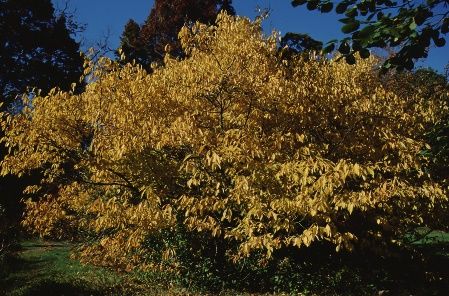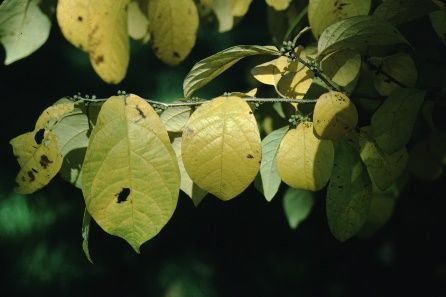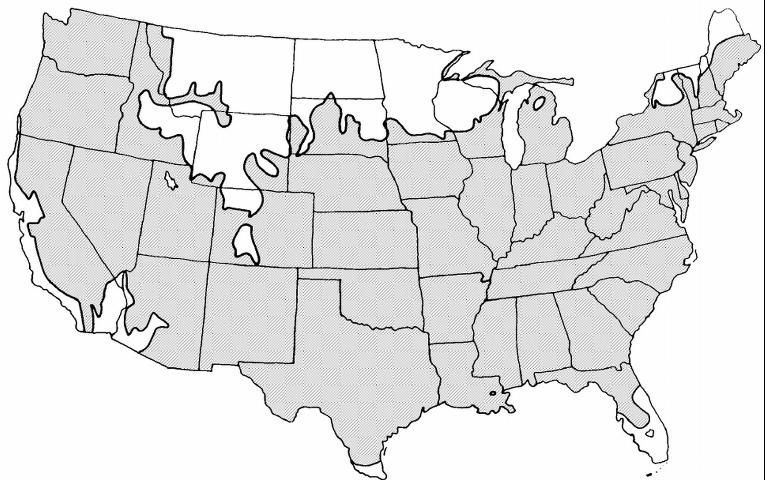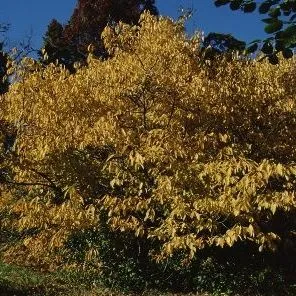Lindera benzoin Spicebush Lindera benzoin Spicebush
Introduction
A large shrub, reaching a 10-foot height and spread, spicebush is so named because of its pleasing aroma when bruised. When planted in a sunny location, spicebush will turn a lovely yellow in the fall but when grown in the shade will not be as colorful or grow as densely. The flowers are insignificant, and fruits form only on female plants.

Credit: Edward F. Gilman, UF/IFAS

Credit: Edward F. Gilman, UF/IFAS
General Information
Scientific name: Lindera benzoin
Pronunciation: lin-DEER-ruh ben-ZOE-in
Common name(s): spicebush, northern spicebush
Family: Lauraceae
Plant type: shrub
USDA hardiness zones: 4B through 9A (Figure 3)
Planting month for zone 7: year-round
Planting month for zone 8: year-round
Planting month for zone 9: year-round
Origin: native to Florida
Invasive potential: not known to be invasive
Uses: border; naturalizing; foundation; mass planting; attracts butterflies
Availability: somewhat available, may have to go out of the region to find the plant

Credit:
Description
Height: 6 to 10 feet
Spread: 6 to 12 feet
Plant habit: round
Plant density: dense
Growth rate: slow
Texture: medium
Foliage
Leaf arrangement: alternate
Leaf type: simple
Leaf margin: entire
Leaf shape: obovate
Leaf venation: pinnate
Leaf type and persistence: fragrant
Leaf blade length: 4 to 8 inches
Leaf color: green
Fall color: yellow
Fall characteristic: showy
Flower
Flower color: yellow
Flower characteristic: spring flowering
Fruit
Fruit shape: oval
Fruit length: 0.5 to 1 inch
Fruit cover: fleshy
Fruit color: red
Fruit characteristic: showy
Trunk and Branches
Trunk/bark/branches: not particularly showy; typically, multi-trunked or clumping stems
Current year stem/twig color: brown
Current year stem/twig thickness: thin
Culture
Light requirement: plant grows in part shade/part sun; plant grows in the shade
Soil tolerances: occasionally wet; acidic; alkaline; sand; loam; clay
Drought tolerance: moderate
Soil salt tolerances: unknown
Plant spacing: 36 to 60 inches
Other
Roots: usually not a problem
Winter interest: no special winter interest
Outstanding plant: not particularly outstanding
Pest resistance: no serious pests are normally seen on the plant
Use and Management
More of a naturalizing plant used in reclamation, spicebush could be brought into the residential or commercial landscape for its nice fall color. It is a large shrub best saved for large scale landscapes, or in the back of a shrub border to be featured in the fall foliage color season.
Although considered difficult to transplant from a field nursery, spicebush has few serious disease problems. There should be little problem establishing the plant from a container.
Pests and Diseases
Few problems warrant concern.



